
Hitec Eco Car – cruising in an electric dwarf
I knew it was small. But I’m surprised it’s that small. The dimensions of the Hitec Eco Car just don’t match my brain’s idea of a «car». But not only the size is different. I get in and rethink.
If you want to drive a Hitec Eco Car, you need a category B or B1 driving license and an ego that is not thirsty for deeper, wider, faster. Reaching top speeds of 80 km/h, this is a small motor vehicle in the truest sense of the word. A low-cost electric alternative for city use that is also easy to maintain. I will not take up the much discussed facts and technical data (both in German) again but, instead, want to tell you about my impressions after a half day of test driving. Check out the video above (English subtitles available in YouTube settings) or keep reading to find out what I thought of the electric diminutive.
Getting in: First impressions
With its vertical cooling grill and big round eyes, the Hitec Eco Car looks like a baby Jeep. Is it really capable of fitting two fully-grown European men? I’m about 1.80 metres tall and can get in quite easily without having to contort myself. Nonetheless, the first thing I do is move the imitation leather driver’s seat to its backmost position to give myself more leg space. So far so good. In the passenger seat beside me is Video Producer Manuel Wenk. He's a few centimetres taller than I am and struggling to get his knees into a good position.
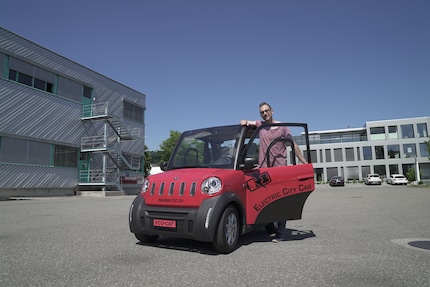
Our heads are relatively close to the panoramic roof but thanks to its generous glass surface, we don’t feel cramped. What is weird, however, is the mini window within the side window – you can only open the inner part. That’s a pity but a concession made to the stability of the construction. The cockpit in front of me has a made-in-China look. The materials used are definitely not premium quality. But as far as technology goes, I’ve got everything I need, particularly for short distance drives: AC, heating, satnav – they’ve even included a rear view camera and a dashcam.
Safety: Depends on what you’re comparing it with
The Hitec Eco Car has no airbags, nor does it have safety assistants like ABS or ESP. It’s a small motor vehicle like a many quad bikes, for example. However, the car is equipped with safety belts and a frame construction including a crush zone in its short snout. So you’re not completely unprotected. Nonetheless, it does feel less safe than a large car. The Eco Car was tested and certified by the Technical Inspection Association TÜV Süd in Germany. The certificate was then forwarded and certified by the Federal Roads Office. But ultimately, it’s a personal decision whether you hit the road on a scooter, a quad bike, in an eco car or a in fully equipped car.
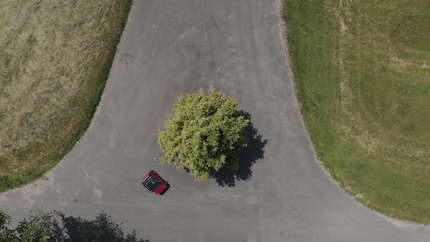
Let’s go: Bzzzzzzz!!!
I turn the key and nothing happens. No coughing, no spluttering, no revving. The AC motor is ready to go. A knob on the dashboard lets me select my driving mode: Eco mode with a top speed limit of 50 km/h, regular mode (D) with 80 km/h tops, neutral gear (N) or reverse (R). I release the handbrake, step on the accelerator and the wee vehicle moves forward with an enthusiastic jolt. It's surprisingly fun to drive – sort of like a go-kart. My driving is soundtracked by a buzzzzzzz that rises as the speed increases. There’s not much insulation here. But hey, who cares?
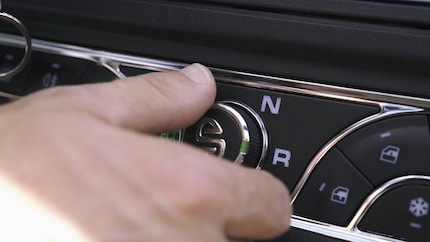
Driving in the city: The electric clown car in its natural habitat
This is where the Hitec Eco Car really comes into its own. Not only does it accelerate to 50 km/h faster than my family car, it’s not going to obstruct traffic thanks to its size and the eco mode doubles up as cruise control. The Eco Car even features hill start assistance. Negotiating bends takes a bit of getting used to as the car has a tendency to oversteer. It’s only 1.29 metres wide so manoeuvring is a doddle – that’s if you’re not stopped and asked what kind of vehicle that is you’re driving.
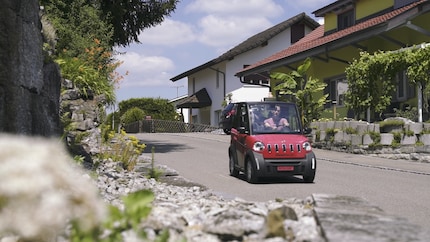
Country roads: Keep it short
It was fine to leave city limits behind me for a few kilometres but I didn’t feel as comfortable at constant full throttle as I did in the city. As it takes a few seconds to accelerate from 50 km/h to top speed, it doesn’t take long until «big» cars are glued to my non-existent rear. What’s more, there’s not much car around me so the trucks thundering past me in the opposite lane are a bit unnerving. The brakes have good grip but I can also feel that the 670 kg Eco Car is heavier than it looks. In any case, driving in the city felt lighter and better.
Parking: Anywhere but on a hill
Parking is this car’s forte – a guaranteed ace up your sleeve whenever there’s a lack of parking spaces. Certain cities allow you to park sideways on the roadside. Plus, as a small motor vehicle, you are even permitted to park on marked parking spots for scooters and motorbikes – as long as they’re not marked as single lot parking spaces. It’s worth checking the options where you live. But even without the above exceptions, you should have no problem finding a parking spot. The only place you won’t be able to leave the Eco Car is on a hill – the manufacturer explicitly says so. The handbrake can’t handle it.
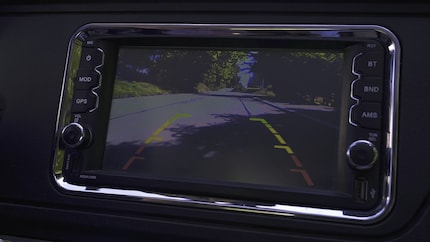
I come to a standstill next to a Nissan Micra that looks like a fully-grown SUV in comparison. If you need it, there’s a rear view camera to help you manoeuvre. After a dramatic pause, it appears on the display as soon as you select reverse gear. Out of habit, I’ve already turned around. My nose is now considerably closer to the rear window than the front window. Everything’s in clear sight even without the use of technology. Nothing’s in the way, except for the relatively loud reverse gear beeping perhaps.
Charging: Don’t wait for red alert
Personally, I don’t really care if the maximum reach is 100 or 120 km. Either would see me through the day in the city or for short stretches – and that's the deciding factor for me when it comes to the Hitec Eco Car. The «boot», which just about fits our two rucksacks, is also home to the 10-metre charging cable. As long as you have a charging possibility at home, you should be fine. Even if you need an unscheduled top-up, your chances of finding a station are OK. All you need is a regular 230V socket. After an hour of charging, you’ll have enough juice for the next 30 kilometres. If the battery is completely drained, charging is said to take five to seven hours. Driving with an empty battery should be avoided altogether as it could damage the car. As soon as you’re in a critical range, the car automatically switches to eco mode.
The conclusion
In the city, I’d love to shrink all those colossal cars containing only one or two passengers. Eco Cars for everyone! At least everyone who’s shorter than 1,90 metres. Driving the Eco Car in the city was great fun – going full throttle at 80km/h less so. Overall, I was only bothered by a few minor things: The indicator lever that doesn’t automatically jump back into place. The thin, revolver-like handbrake I struggled with at the start. The main switch I accidentally activated with my left knee whilst getting in and that left me wondering why the car wouldn’t budge anymore. The switch is actually a battery protection during long periods of non-use. Generally speaking, there was nothing that truly put me off. However, in order to warm to the Hitec Eco Car, you must be prepared to rethink things a little. Like what makes a car a car? But if you believe less is often more in an urban environment, this might just be an interesting second car for you.

Simple writer and dad of two who likes to be on the move, wading through everyday family life. Juggling several balls, I'll occasionally drop one. It could be a ball, or a remark. Or both.